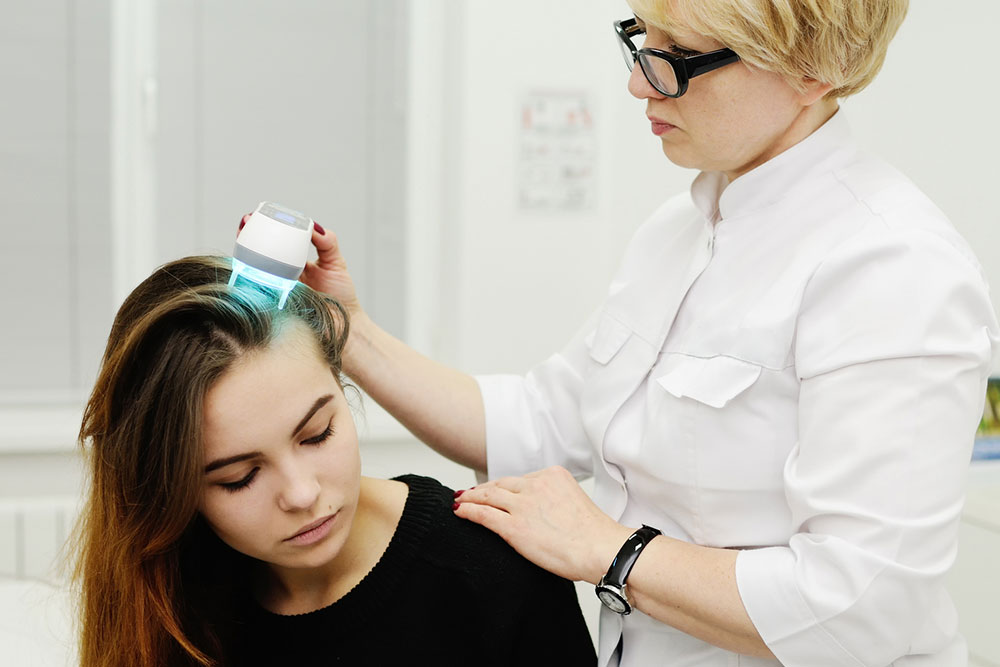Scalp Psoriasis – What Is It and How to Identify It
Scalp psoriasis is an autoimmune health condition. Here, an overactive immune system makes the skin cells reproduce at an abnormally high rate. The buildup of new skin cells causes thick and discolored patches of skin to develop on the scalp, along with irritation and other symptoms. It is important to recognize and address the symptoms to relieve discomfort associated with scalp psoriasis. Those who notice the signs should consult a licensed healthcare professional.
What does scalp psoriasis look like?
Psoriasis leads to a buildup of cells on the skin. As a result, rashes and plaques begin to develop on the scalp and other affected parts of the body.

Identifying scalp psoriasis
- Keep an eye out for silvery scales on the scalp.
- Flaky, dry skin resembling dandruff can also indicate scalp psoriasis.
- Watch out for issues like frequent itching, burning, or discomfort.
Often, the symptoms flare up or worsen due to stress, infection, and other triggers that increase inflammation in the body. If one is trying to picture what psoriasis of the scalp looks like, its appearance can vary depending on the skin tone. On lighter skin tones, the psoriasis manifests as pink or red patches with silver-white scales. On darker skin tones, scalp psoriasis develops as dark brown or purple patches with gray scales. As a dry and flaky scalp with occasional itchiness is a tell-tale sign of scalp psoriasis, the condition can often be confused with dandruff and seborrheic dermatitis.
Scalp psoriasis versus dandruff
Often, scalp psoriasis can be mistaken for dandruff due to an overlap in symptoms. Both can lead to the development of skin flakes on the scalp, mild redness, itchiness, and dryness on the scalp. But unlike scalp psoriasis, dandruff does not cause thick and raised skin plaques with defined borders. This is how one can differentiate between the two.
Scalp psoriasis versus seborrheic dermatitis
Like dandruff, seborrheic dermatitis has a few symptoms in common with scalp psoriasis. Knowing the differences can help one understand how to differentiate between a rash and scalp psoriasis. A healthcare provider can typically tell whether one has scalp psoriasis, seborrheic dermatitis, or both by observing the skin, nails, and scalp. Both conditions affect the scalp and result in inflamed, scaly skin. Yet, the scales associated with psoriasis can be thicker and drier than those caused by seborrheic dermatitis. In addition, psoriasis usually extends beyond the hairline, whereas seborrheic dermatitis is limited to the scalp. Also, psoriasis affects more than one area of the body. For instance, one with scalp psoriasis may experience mild psoriasis on their lower back, knees, and elbow. Additionally, when dealing with psoriasis, one may be able to observe changes in nails, such as pitting.
Managing scalp psoriasis
Avoid scratching the scalp: Scalp psoriasis can cause itchy scales. However, scratching them will only worsen the condition. Scratching and picking on the scales can cause bleeding and hair loss, which will become quickly apparent.
Seek treatment for the symptoms: The itching stops as soon as scalp psoriasis scales clear. This can only happen by undergoing psoriasis treatment. So, one should consult a dermatologist upon noticing the first visible signs of scalp psoriasis and seek an appropriate treatment plan.
Be gentle with the scalp: Vigorously rubbing shampoo on the scalp may seem like a way to get rid of the scales, skin debris, and scaly matter. However, this will only make things worse, resulting in further irritation. So, one should avoid rubbing, scrubbing, or scratching the scalp. One should always opt for gentle and slow motions while using shampoo or any other hair or scalp product.
Remove the scales with care: The scales tend to become loose while undergoing treatment for scalp psoriasis. One should remove them gently and avoid picking on them to reduce the risk of hair loss and flare-ups.
Clean combs or brushes regularly: Raised patches on the scalp can make it difficult to comb or brush the hair. So, one should be gentle while combing or brushing their hair and opt for a soft-bristle hair brush or comb. Also, one should clean the tool after every use to lower the risk of infection.
Manage stress: Stress is a known trigger for scalp psoriasis flare-ups. So, it is essential to keep stress levels in check through relaxation techniques like deep breathing or yoga, exercising, or indulging in a hobby.

